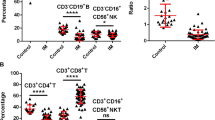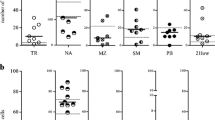Summary
Equine infectious anemia (EIA) is a disease caused by a lymphocytotropic lentivirus which belongs to the same subfamily as HIV. Because of the very close relationship of their predictedgag andpol gene products and similarities in clinical manifestations of the disease, EIA served as a model to study immunological events involved in the host defence against lymphocytotropic viral infections. The existence of antibody dependent cell-mediated cytotoxicity against autologous EIA virus infected lymphoblasts was demonstrated in vitro at the beginning of an acute attack of the disease. Cytotoxic activity was not found or was very low during chronic infection. Reactivity of peripheral blood lymphocytes to Protein A and allogeneic cells in vitro was significantly suppressed in the presence of an acute serum, while the reactivity to PHA was at the normal level. These results suggest that cellular immune mechanism(s) are also involved in removal of EIA virus infected cells as has been reported recently in HIV-1 infected individuals and that EIAV and HIV immunopathogenesis show similarities in affecting the immune response of the host.
Similar content being viewed by others
References
Askonas BA, Taylor PM (1987) T cell mediated immunity in virus infection. Immunol Lett 16: 337–340
Blumberg RS, Paradis T, Hartshorn KL, Vogt M, Ho DD, Hirsch MS, Leban J, Sato VL, Schooley TR (1987) Antibody-dependent cell-mediated cytotoxicity against cells infected with the human immunodeficiency virus. J Infect Dis 156: 878–884
Casey JM, Kim Y, Andersen PR, Watson KF, Fox JL, Devare SG (1985) Human T-cell lymphotropic virus type III: immunologic characterization and primary structure analysis of the major internal protein p24. J Virol 55: 417–423
Cheevers WP, McGuire TC (1985) Equine infectious anemia virus: immunopathogenesis and persistence. Rev Infect Dis 7: 83–88
Chiu IM, Yaniv A, Dahlberg JE, Gazit A, Skuntz SF, Tronick SR, Aaronson A (1985) Nucleotide sequence evidence for relationship of AIDS retrovirus to lentiviruses. Nature 317: 366–368
Cunningham-Rundles S, Michelis MA, Masur H (1983) Serum suppression of lymphocyte activationin vitro in acquired immunodeficiency disease. J Clin Immunol 3: 156–165
Eales LJ, Parkin JM (1988) Current concepts in the immunopathogenesis of AIDS and HIV infection. Br Med Bull 44: 38–55
Eichberg JW, Zarling JM, Alter HJ, Levy JA, Berman PW, Gregory T, Lasky LA, McClure J, Cobb KE, Moran PA, Hu SL, Kennedy RC Chanh TC, Dreesman GR (1987) T-cell responses to human immunodeficiency virus (HIV) and its recombinant antigens in HIV-infected chimpanzees. J Virol 61: 3804–3808
Fauci AS (1988) The human immunodeficiency virus: Infectivity and mechanisms of pathogenesis. Science 239: 617–622
Fujimiya Y, Perryman LE, Crawford TB (1979) Leukocyte cytotoxicity but absence of antibody-dependent cellular cytotoxicity in horses infected with equine infectious anemia virus. Infect Immun 24: 628–636
Lane HC, Depper JM, Greene WC, Whalen G, Waldmann TA, Fauci AS (1985) Qualitative analyses of immune functions in patients with the acquired immunodeficiency syndrome: evidence for a selective defect in soluble antigen recognition. N Engl J Med 313: 79–84
Lanier LL, Kipps TJ, Phillips JH (1985) Functional properties of a unique subset of cytotoxic CD 3+ T lymphocytes that express Fc receptors for IgG (CD 16/Leu-11 antigen). J Exp Med 162: 2089–2106
Ljunggren K, Fenyö EM, Biberfled G, Jondal M (1987) Detection of antibodies which mediate human immunodeficiency virus-specific cellular cytotoxicity (ADCC)in vitro. J Immunol Methods 104: 7–14
Montelaro RC, Parekh B, Orrego A, Issel CJ (1984) Antigenic variation during persistent infection by equine infectious anemia virus, a retrovirus. J Biol Chem 259: 10539–10544
Oldstone MBA (1979) Immune responses, immune tolerance and viruses. In: Frankel-Conrat H, Wagner RR (eds) Comprehensive virology, vol 15. Plenum, New York, pp 1–36
Payne SL, Fang FD, Liu CP, Dhruva BR, Rwambo P, Issel CJ, Montelaro RC (1987) Antigenic variation and lentivirus persistance: variations in envelope gene sequences during EIAV infection resemble changes reported for sequential isolates of HIV. Virology 161: 321–331
Plata F, Autran B, Pedroza-Martins L, Wain-Hobson S, Raphael M, Mayaud C, Denis M, Guillon JM, Debre P (1987) AIDS virus-specific T lymphocytes in lung disorders. Nature 328: 348–351
Rook AH, Lane HC, Folks T, McCoy S, Alter H, Fauci AS (1987) Sera from HTLV-III/LAV antibody-positive individuals mediate antibody-dependent cellular cytotoxicity against HTLV-III/LAV infected T cells. J Immunol 138: 1064–1067
Rushlow K, Olsen K, Stiegler G, Payne SL, Montelaro RC, Issel CJ (1986) Lentivirus genomic organization: the complete nucleotide sequence of theenv gene region of equine infectious anemia virus. Virology 155: 309–321
Salinovich O, Payne SL, Montelaro RC, Hussain KA, Issel CJ, Schnorr KL (1986) Rapid emergence of novel antigenic and genetic variants of equine infectious anemia virus during persistent infection. J Virol 57: 71–80
Sattentau QJ, Weiss RA (1988) The CD4 antigen: physiological ligand and HIV receptor. Cell 52: 631–633
Sherman L, Gazit A, Yaniv A, Kawakami T, Dahlberg JE, Tronick SR (1988) Localization of sequences responsible for transactivation of the equine infectious anemia virus long terminal repeat. J Virol 62: 120–126
Stephens RM, Casey JW, Rice NR (1986) Equine infectious anemia virusgag andpol genes: relatedness to visna and AIDS virus. Science 231: 589–594
Valpotic I, Gerenčer M, Zilic M, Basic I (1986) Cryopreservation of horse, swine, dog and rat lymphocytes for cellular testings. Vet Arhiv 56: 159–168
Walker BD, Chakrabarti S, Moss B, Paradis TJ, Flynn T, Durno AG, Blumberg RS, Kaplan JC, Hirsch MS, Schooley RT (1987) HIV-specific T lymphocytes in seropositive individuals. Nature 328: 345–348
Weinhold KJ, Matthews TJ, Ahearne PM, Langlois AJ, Lyerly HK, Tyler DS, Stine KC, Durack DT, Bolognesi DP (1988) Cellular anti-gp 120 cytolitic reactivities in HIV-1 seropositive individuals. Lancet I: 902–905
Zarling JM, Morton W, Moran PA, McClure J, Kosowski SG, Hu SL (1986) T-cell responses to human AIDS virus in macaques immunized with recombinant vaccinia viruses. Nature 323: 344–346
Zarling JM, Moran PA, Grosmaire LS, McClure J, Shriver K, Ledbetter JA (1988) Lysis of cells infected with HIV-1 by human lymphocytes targeted with monoclonal antibody heteroconjugates. J Immunol 140: 2609–2613
Author information
Authors and Affiliations
Rights and permissions
About this article
Cite this article
Gerenčer, M., Valpotić, I., Jukić, B. et al. Qualitative analyses of cellular immune functions in equine infectious anemia show homology with AIDS. Archives of Virology 104, 249–257 (1989). https://doi.org/10.1007/BF01315547
Received:
Accepted:
Issue Date:
DOI: https://doi.org/10.1007/BF01315547




